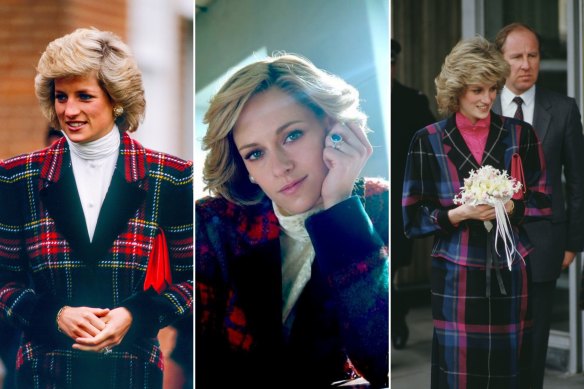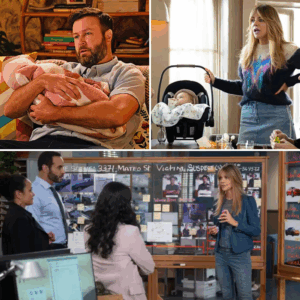The Vision of Spencer
Spencer, written by Steven Knight and directed by Pablo Larraín, is described as “a fable from a true tragedy,” focusing on Diana’s internal struggle rather than a factual recounting of her life. Set over Christmas Eve, Christmas Day, and Boxing Day in 1991, the film portrays Diana as she navigates the stifling protocols of the royal family, her deteriorating marriage to Prince Charles (played by Jack Farthing), and her own mental health challenges, including bulimia and feelings of isolation. The film blends elements of psychological drama with gothic horror, presenting Diana as a woman on the brink, haunted by visions of Anne Boleyn and yearning for freedom.
Stewart was an unexpected choice for the role, given her association with mainstream projects like The Twilight Saga. However, Larraín saw her as the perfect fit, citing her ability to embody mystery, fragility, and strength—qualities essential to portraying Diana. “Kristen can be many things, and she can be very mysterious and very fragile and ultimately very strong as well, which is what we need,” Larraín told Deadline. Her personal experience with fame and media scrutiny, particularly during her Twilight years, allowed her to connect deeply with Diana’s sense of being hounded by the press.
Stewart’s Preparation for the Role
To embody Princess Diana, Stewart undertook an intensive preparation process that spanned several months. She immersed herself in research, reading extensively about Diana’s life, watching documentaries, and studying The Crown, which provided a broader context for the royal family’s dynamics. “I read everything. And somehow, in a sort of abstract way, the script substantiated everything I learned in detail,” Stewart told Variety at the film’s Los Angeles premiere.
One of the most challenging aspects of the role was mastering Diana’s distinctive voice and mannerisms. Stewart worked with dialect coach William Conacher, who had previously coached Emma Corrin for The Crown and Naomi Watts for Diana (2013). She spent months perfecting Diana’s high-born accent, clipped speech patterns, and breathy tone, which she described as a “huge way that she communicated” through a “veil” of restraint. Stewart admitted to feeling nervous about getting the voice right, only feeling confident on the first day of shooting when Larraín reassured her to trust her preparation. “Pablo had to come up to me and like, tug the leash a bit… He was like, ‘Kristen, you got it. You have to trust that you’ve been spending months and you have this beautiful coach,’” she recalled.
Beyond the voice, Stewart focused on capturing Diana’s physicality—her hunched shoulders, tilted head, and nervous glances—which conveyed a sense of vulnerability and entrapment. She studied Diana’s mannerisms to replicate her “shoulder-shrugging convulsions of misery,” as described by The Guardian, while infusing the role with her own modern sensibilities. The film’s costume designer, Jacqueline Durran, played a crucial role in this transformation, recreating iconic Diana looks, including a beige organza gown from Chanel’s 1988 haute couture collection that took over 1,034 hours to craft. Stewart noted that the wardrobe helped her feel Diana’s struggle, as the meticulously chosen outfits symbolized the royal family’s control over her.
Stewart’s preparation was not just technical but deeply emotional. She spoke of feeling a “spooky, spiritual” connection to Diana, as if the late princess had given her a “sign-off” during filming. “She felt so alive to me when I was making this movie, even if it’s all between the ears and it was just a fantasy of mine,” Stewart told the Los Angeles Times. This sense of connection allowed her to channel Diana’s emotional intensity, particularly in scenes depicting her bulimia and paranoia.
The Performance: A Masterclass in Emotional Depth
Stewart’s performance in Spencer is a tour de force, blending raw emotion with subtle precision. Critics have praised her ability to disappear into the role, creating a Diana who is both recognizable and refracted through Stewart’s own lens. Variety described her performance as “finely modulated,” anchoring the film’s “flights of fancy,” while Awards Daily called it “one for the ages.” Her portrayal is marked by several key elements:
Emotional Vulnerability: Stewart captures Diana’s fragility with a brittle intensity, evident in scenes where she struggles with bulimia or confronts the royal family’s cold formality. Her breathy, clipped delivery and nervous glances convey a woman “gasping for air,” as noted by ABC News. Moments like Diana’s interactions with her sons, William and Harry (Jack Nielen and Freddie Spry), reveal her tenderness as a mother, with improvised scenes like a Truth or Dare game showcasing her warmth and playfulness.
Physical Transformation: Stewart’s physicality is a standout feature, with her hunched posture and darting eyes evoking Diana’s sense of being watched and trapped. NPR noted that her “showier mannerisms” took some getting used to but ultimately created a compelling portrait of a woman on the edge. Her ability to convey tension through small gestures, like clutching a pearl necklace or pacing Sandringham’s hallways, adds depth to the film’s claustrophobic atmosphere.
Psychological Complexity: Spencer frames Diana’s story as a gothic horror narrative, with Stewart portraying her as a woman teetering between reality and hallucination. Her visions of Anne Boleyn, a nod to Diana’s fear of being discarded like the beheaded queen, are handled with a delicate balance of fear and defiance. Stewart’s performance avoids caricature, grounding even the film’s most surreal moments in emotional truth.
Relatability and Modernity: Stewart infuses Diana with a contemporary edge, portraying her as a rebel against tradition. Scenes where she wears a parka over a princess dress or craves fast food highlight her desire to break free from royal constraints, resonating with modern audiences. ABC News described this as Diana being “a lot cooler here than she was in real life,” reflecting Stewart’s ability to make her relatable to younger viewers.
Stewart’s personal experiences with fame added authenticity to her portrayal. “I know what it feels like to always assume, whether you’re right or wrong, that everyone’s looking at you,” she told Slant Magazine. This allowed her to empathize with Diana’s struggle under media scrutiny, making her performance both personal and universal.
Critical and Audience Reception
Upon its premiere at the Venice Film Festival on September 3, 2021, Spencer received a three-minute standing ovation, with critics lauding Stewart’s performance. Rotten Tomatoes reported an 83% positive rating from 351 reviews, with the consensus stating that Stewart’s “finely modulated performance anchors the film’s flights of fancy.” Metacritic gave the film a score of 76/100, indicating “generally favorable reviews.”
Critics were divided on the film’s artistic liberties, with some, like The Guardian, calling it “overwrought” and others, like NPR, praising its “unconventional” approach. However, Stewart’s performance was a near-universal highlight. CBS News noted that she “seems to nail every detail, from her high-born accent to her kind-of-trapped-animal look,” while former royal bodyguard Ken Wharfe remarked, “Out of all the people who have played Diana over the past 10 years, she’s the closest to her. She managed to perfect her mannerisms.”
Not all reactions were positive. Royal expert Stewart Pearce argued that the portrayal was “not Diana,” criticizing its focus on a “neurotic disposition” rather than her “sparkling authenticity.” The San Francisco Chronicle called it a “disservice” to both Diana and Stewart, citing an exaggerated performance. On X, opinions were mixed, with users like @JorCru praising Stewart’s “graceful contained explosion” and @PhilMphela calling her “enchanting,” while others found her mannerisms “cringe-worthy.”
Stewart’s performance earned nominations for the Academy Award, Golden Globe, and Critics’ Choice Award for Best Actress, solidifying its impact. Forbes reported that the role “thrusts” her into the Oscar race, a testament to its transformative power.
Challenges and Personal Impact
Stewart faced significant pressure in taking on such an iconic figure. She admitted to CBS News that her body manifested anxiety before filming, to the point where she “couldn’t open my mouth” due to stress. “I really didn’t want to mess this one up,” she said. Her commitment to the role was so intense that she described “pummeling” herself into it, feeling a “spooky transference” of Diana’s energy.
The role also resonated with Stewart on a personal level. Her own experiences with paparazzi scrutiny, particularly during her Twilight years, mirrored Diana’s struggles. “The idea of somebody being so desperate for connection… and feeling so bad on the inside, and being so generous with her energy—I just think we haven’t had many of those people throughout history,” she told The Daily Beast. This connection allowed Stewart to deliver a performance that felt authentic and deeply felt.
Legacy of the Performance
Stewart’s portrayal of Diana in Spencer has redefined her career, showcasing her evolution from a blockbuster star to a versatile actress capable of tackling complex, historical roles. The performance stands alongside her work in films like Clouds of Sils Maria and Personal Shopper, but its emotional depth and cultural resonance make it a career highlight. The Hollywood Reporter noted that Stewart’s ability to “cut through the noise” of the “Dianassance” underscored her skill, while ABC News called it a “thrilling” variation on a single note of melancholy.
The film’s focus on Diana’s inner life, rather than a chronological retelling, allowed Stewart to explore uncharted territory, presenting a Diana who is both a historical figure and a cinematic creation. This approach sparked debates about accuracy but also highlighted Stewart’s ability to convey universal emotions through a specific lens. As she told Variety, “It’s what did it feel like to be her, think about what those nights were like, think about what those meals were like.”
Conclusion
Kristen Stewart’s performance in Spencer is a testament to her growth as an actress and her ability to embody one of the most iconic figures of the 20th century. Through meticulous preparation, emotional vulnerability, and a bold reinterpretation of Diana’s story, Stewart delivered a portrayal that is both haunting and human. Despite mixed reactions to the film’s artistic choices, her work has been celebrated as a career-defining achievement, earning her a place among the greats in cinematic history. As Spencer continues to resonate with audiences, Stewart’s Diana remains a powerful reminder of the strength found in vulnerability and the enduring allure of a woman who captivated the world.





